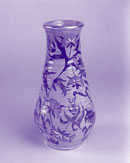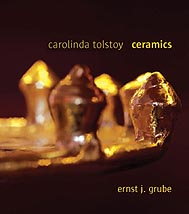




 |
    |
Reviews |
||
 |
Libas InternationalJuly 2004 Volume 17 Issue 2 In the Orientalist Tradition Countess Carolinda Tolstoy's stunning pieces are inspired principally by the pottery of the Muslim Middle East, as Ernst J. Grube's book 'Carolinda Tolstoy - Ceramics' illustrates. With her dark hair and eyes, her flowing kaftan and the rows upon rows of beads around her neck, there is something unmistakably oriental about Countess Tolstoy. Indeed she is the descendant of an old Middle Eastern family, although she spent her childhood between Hampshire and King's Road in London. She is also linked to one of the great families of Russia - for twenty seven years she was married to Count Andrei Tolstoy, a distant relation of the famous writer. Her pottery shows some preoccupation with Russia, and the onion-shaped domes of its churches. But as the author of this visually enthralling book writes, Countess Tolstoy is best known for the way she has "taken up, in a unique way, the tradition of perpetuation of Near Eastern pottery design by European artists" Till the age of 22, Carolinda's creativeness found an outlet in the world of fashion - she designed and made belts for Christian Dior and Yves Saint Laurent. She then began work on the production line of the Chelsea Pottery, and her earthenware, inspired by Middle-Eastern ceramics, became a passion and then a career. She has taken this passion to an apogee. Her work is collected by leading ceramic specialists. She spent the summer of 2003 designing a collection for the maiolica factory in Deruta, Italy, and this year she takes part in an exhibition of new pottery that will be run in conjunction with an Islamic exhibition at the Getty Museum. Her work is avidly collected by a growing number of collectors and connoisseurs. Ernst J. Grube writes in his introduction: "Fascinated by both the floral and abstract geometric patterns of Islamic Art, she has developed a style of ceramic painting that combines elements of both these forms of decoration, creating patterns of great beauty and energy". For purposes of clarity Grube has divided the book into various sections, according to the kind of decoration based on Islamic motifs that Carolinda chooses to decorate her pottery with: there is the lily, the carnation, the scroll (Alexandro, Mandu, Iskander, Sweeping Leaves) and the arabesque, etc. For the majority of her patterns she goes back to the 16th century Ottoman Turkish ateliers which flourished in many parts of the Ottoman Empire. Ottoman floral ceramic decoration reached its peak in the ateliers of Iznik and Kutahya and was a huge influence on Italian ceramicists. They were deeply impressed by Islamic patterns and the development of polychrome painted maiolicas is the ultimate manifestation of this Islamic influence, which ran strong through the 16th and 17th centuries. Carolinda's designs for the Deruta maiolica factory highlight the synthesis of an atelier and the individual, both indebted to this unique Islamic decorative tradition. Another significant element of Carolinda's work is decorating a surface by painting it with metallic lustre. This technique invented by Muslim potters of the Abbasid period in the early 19th century, and again adopted by the West, this time by the ceramic ateliers of Spain. However, Carolinda uses lustre in a very different way; in her favoured palette of colours, pink is as ubiquitous as white in most conventional ones. In a way this colour ties her more to English potters (from both the 18th and early 19th centuries), than to conventional Islamic models. Grube traces the influence of Islamic pottery decoration on many other movements and individuals. For example, apart from the maiolica ware of the many Italian ateliers, there was the Zsolnay Manufactory of Pecs in Hungary, which fashioned forms of the purest Ottoman design, using the talents of the French ceramicist Theodore Deck. He also mentions the work of other 'orientalist' potters, such as William De Morgan. In fact, Grube finds further examples of many famous ceramicists who owe much to Islamic pottery. As he says, "even certain ceramics decorated by Andre Derain, Henri Matisse and Maurice de Vlaminck show the continuous fascination of contemporary artists with the shapes, the colours, and even the individual forms of Islamic ceramic designs. Ernst J. Grube was born in Austria in 1932 and educated in Berlin, Germany. He completed his PH.D. from Freie Universitat in Berlin before working as an assistant to Ernst Kyhnel at the Berlin Museum. In 1956 he joined the Metropolitan Museum of Art in New York. He was curator at the Met as the same time as being adjunct Professor of Islamic Art at Columbia University. He has been professor of Islamic Art at the universities of Padua and Venice, and at the Oriental Institute in Naples. In 1980 he established the annual 'Islamic Art', published jointly the East-West Foundation, New York, and the Bruschettini Foundation of Islamic and Asian Art, Genoa. He is Presidents of New York's Islamic Art Foundation. Since 1988 he has devoted his time mainly to research and writing on Islamic Art. This is the first time he has written about a living British ceramicist.
|
 |
| © Carolinda Tolstoy 1999-2018 | Web site design: QuincDigital |